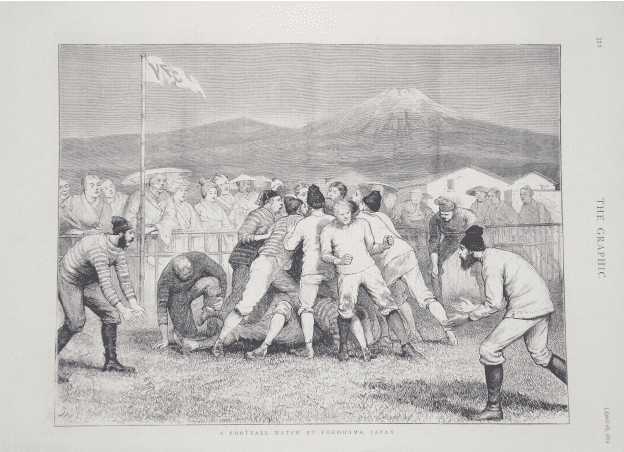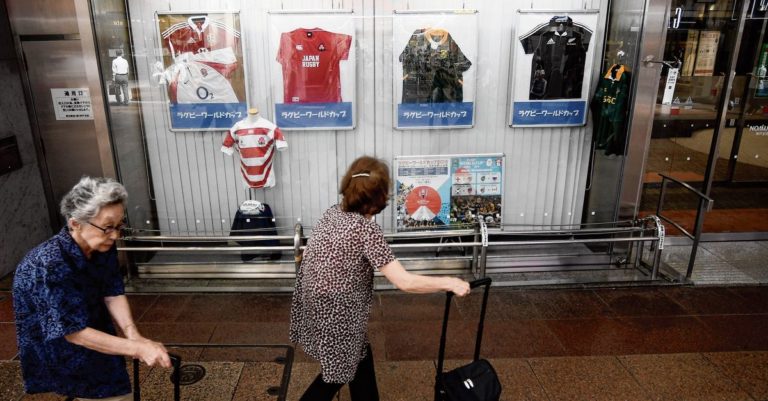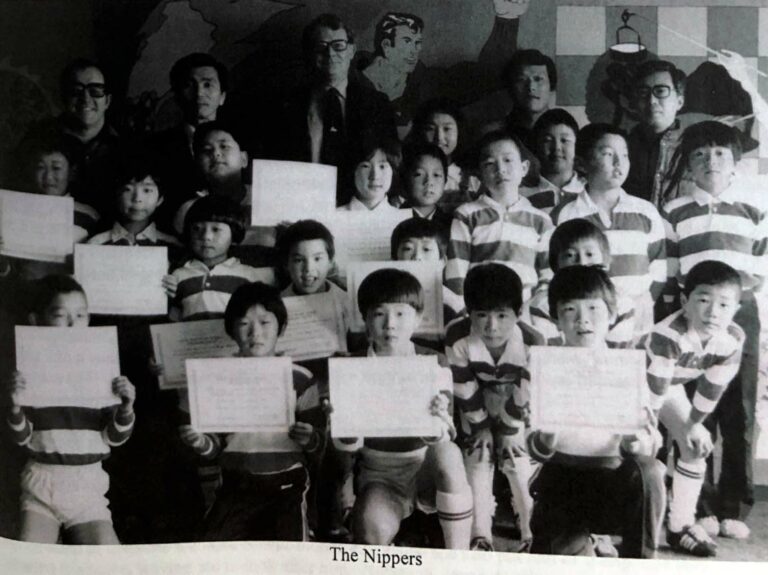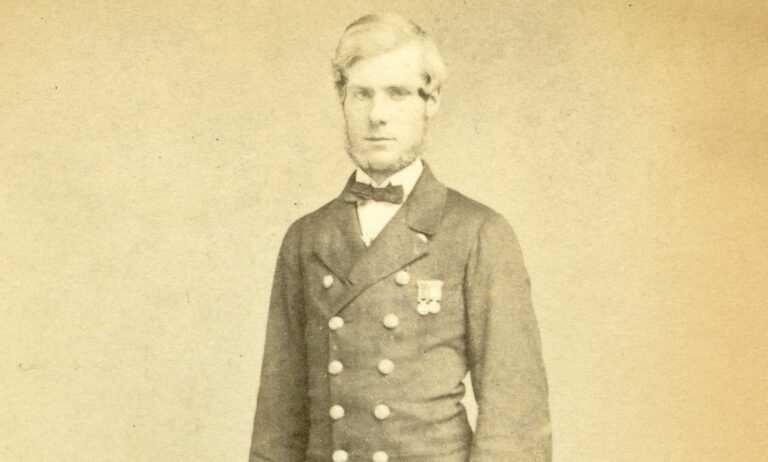YC&AC 100 YEARS AGO DURING WW1
The YC&AC grounds and sports facilities at Yaguchidai have been enjoyed by the club’s sporting members for just over 100 years and those of no other “open” club in Japan’s major cities come anywhere near matching them. Many members over those years happily played field sports at the YC&AC for ten or even twenty years or more.
However, the generation of YC&AC members who bequeathed us this splendid legacy by their initiative to raise money (they raised about 55,000 yen or about 90% of the costs!), acquire the land on the hill in Yaguchidai, and convert it into the flat sports field officially opened in June 6 1914, were not so fortunate. Within a few weeks, on July 28, WW1 began and European nationals were soon called upon to sign up to fight for their countries.
The war in Europe must have seemed far away to the Europeans residents in Japan and it was. Moreover. as Japan was an ally, the peer pressure to enlist to fight was not nearly as strong as it was back home. Nonetheless, some were quick to answer the call to fight for their home country.
J. P. MOLLISON’S TWO SONS SET AN EXAMPLE
For example, the two sons of YC&AC founder J. P. Mollison were quick to sign up to serve their country, with James Murray Mollison enlisting as a private in the 1st Reinforcement of the 15th Battalion of the Australian Commonwealth Military Forces on November 14 1914 in Australia. The 15th Battalion was in the forefront of the Gallipoli landings in April 1915 but it appears Mollison may have been transferred to the IAF HQ.
His brother John Pender Duff Mollison who had been working in a bank in London, resigned on September 19 1914 and obtained a commission in the Queen’s Glasgow Yeomanry. He spent the war in Palestine and Egypt and was a Captain at the end of the war.
Both brothers survived WW1 but John was to tragically die in the 1923 earthquake.
STEADY DECLINE IN MEMBERSHIP
Accordingly the membership of the YC&AC went into a gradual but steady decline from 320 members in February 1914 to 219 members in February1918. The biggest drop, not surprisingly, was in the year up to February 1916 when the drop was 48.
Those who went off to fight included some of the best athletes but throughout the war the sports fixtures, including Interports, continued more or less as normal. However, the black clouds of war and death hung over all events growing darker year by year and team captains often had to struggle harder and harder to find enough players.
SOME SPORTS THRIVE AND OTHERS STRUGGLE TO PUT A TEAM OUT
Rugby, which required more players – 15 – than other sports, was soon to be affected. According to the report given at the 1915 AGM, the first wartime season got off to a strong start under the captainship of N. Buckle and the club easily beat Keio 19 points to 5. “However, since a large number of Rugby members have left Japan for various reasons and a weak Y.C. & A. C. 1st XV was defeated in December on the Yokohama Ground by 18 points to 6. Unfortunately, it has been found impossible to get together full XV.’s for practice games, and interest in the game has naturally fallen off. [Note English looks strange but that is the way it is! Mike]
Rugby’s loss was a gain for Soccer, with the captain, V. A. Hearne, reporting a very satisfactory season “as owing to the Rugger men not being able to get full sides, the Soccer players have had the use of the Ground on most Saturdays.” There were 14 “Club games” and one “outside” game against the S.S. Nagoya which the club won 20 goals to 1 (Is this a YC&AC record score?). The club won the first ever Interport against Kobe played on the Yokohama ground by two goals to one.
YC&AC cricketers thrived in that first year of the war and it was reported that “full use was made of the new Club Grounds.” The Interport, played in Kobe with YC&AC winning by 3 wickets, was notable for its high scores. YC&AC captain A. P. Scott hit a record 165 while W. D. S. Edwards scored a magnificent 86.
Hockey also had a good season. Despite the captain P. A. Cox making an early departure from Japan, under his replacement T. M. Knot the section went from strength to strength. They even got permission from the city authorities to borrow the “Settlement Ground” (presumably the “new” ground in a corner of Yokohama Park) for noon practices twice a week. It was reported that “these games have been well supported, full sides being available for the majority of the games.” There were three hockey matches against the Keio hockey club, winning the first in Tokyo 1-0, losing the second, also in Tokyo, 4-8 and tying the home match 3-3. Preparing for the Interport, the YC&AC beat the Tokyo Hockey Club 4-2 at home on February 13 but a week later lost the key Interport match on their home ground 4-1.
The YC&AC baseball season was blighted by the Interport in Kobe when the club was forced to forfeit the series after they played a non-member player.
Perhaps tennis was the most popular sport at the club in the first year of the war. “Considerable interest has been shown in this branch, and the hard courts have had continual use.” The hard courts were used so much that in places the surface was worn off and the foundations exposed.
Four new grass courts were opened in August 1914 but “as the ground was still soft and the surface consequently slow, the courts were not used to any great extent. These courts will, however, be in excellent condition for the coming season.” Following numerous complaints about the quality of the tennis balls, the club decided to allow members to purchase their own balls by paying half the cost.
Tournaments for Singles (won by W. A. Tomlinson) and Doubles (won by C. H. Thorn and R. H. Blair) were the first ever tennis tournaments held on the Yaguchidai ground courts.
1916-17 REPORT SHOW MOST SPORTS IN REASONABLE HEALTH
Two years later the YC&AC AGM at the end of February 1917 offers another snapshot of the sporting activities of club members and on the surface things are not too bad. The committee started its annual report by naming the four members who had died ‘at the front’: J. Barnes, G. W. Hawkins, T. H. G. Kenderline, and C. Sellier.
In its round-up of the main sports, the first to get a mention was the ‘Sports Meeting’ (athletics) held on June 10th 1916 which featured “good entries and close races.”
Next up was baseball, captained by C. H. Thorn with K. F. Coe as vice captain and L. M. Howe acting as manager. The team was looking good until the game against the club’s old rivals the Tokyo Americans played on July 4 which they lost 19 – 1. This had demoralized the players. Nevertheless the team for the coming season promised to be the best for several years.
The report on cricket noted that “there was considerable difficulty in raising full sides, but under the present circumstances this was not to be wondered at.” The Interport was played at Kobe and Kobe won.
The YC&AC soccer team won, for the second year running, the newly formed League set up in 1915 on the initiative of William Haigh who managed and captained the Tokyo AFC. However, one game had to be forfeited “due to insufficient support.” Meanwhile the Interport was a 1-1 draw.
The rugby section, which was also captained by B. Deveson after the elected captain was transferred to China and the vice-captain fell ill, managed to win their Interport 8-3 at home and of its three games against Keio, it won one, drew one and lost one. Nonetheless the summary stated that “The prospects are not encouraging, and the game has not been well-supported this season.”
The story was similar with the Hockey team which was obliged to abandon its twice weekly practice games in Yokohama Park: “Some of last year’s players have left, others have become incapacitated or too busy to turn out, while a marked falling off was evident among the younger players, which is to be regretted.”
It was only tennis that appeared to attracting more interest both in terms of players and spectators for its expanded program of tournaments. I. M. Isaacs, son the Sigmund Isaacs, was the singles champion.
YOKOHAMA SPORTS IN CRISIS AS WAR ENDS
By the time of the AGM in February 1919, WW1 was over but the report indicated that the war had finally having a major negative impact on sporting life in Yokohama.
“Owing to the absence at the front of many of the athletes of the Club there had been less interest in sport. There had been no athletic meeting, no hockey and no rugby football. Soccer, baseball, cricket and tennis found some support during the season.”
ENTERTAINING AFTER INTERPORTS GRADUALLY REPLACED BY FUNDRAISING FOR WAR CHARITIES
Until 1917-18 key Interports involving the Yokohama and Kobe teams were still followed by formal dinners with numerous toasts and speeches.
However, in the 1917-1918 period there is suddenly a trend towards forgoing the entertainment and donating the money to various war charities. Entrance fees were also charged to watch Interport matches and the tennis tournament entrance fees were donated instead of spending the money on prizes. It was reported in the 1918 AGM that 868.40 yen had been raised by these means and delivered to the Ladies Relief Fund, which forwarded what it received to the French, British, and Belgian Red Cross Societies, the American Relief Fund and the British Red Cross. Just the week before the AGM, the Hockey Interport resulted in 900 yen being given to the French Red Cross through the Alliance Francaise.
SIDEBAR: YOKOHAMA-BORN GEORGE WHEELER AWARDED VC IN 1917
George Campbell Wheeler was born in Yokohama in 1880, the son of long-term resident
and YC&AC member Dr. Edwin Wheeler who was a keen and talented footballer and cricketer – one of the best of YC&AC’s bowlers. He was also keen on horseracing and sailing, and, more significantly, president of the YC&AC from??? till 1910.
At the age of 13 George Campbell Wheeler started school at Bedford School in England. Soon after finishing school he joined the 2nd Battalion of the 9th Gurkha Rifles, becoming a 2nd Lieutenant in January 1900, a Lieutenant two years later and a Captain in 1909. When his battalion was dispatched to fight the Turkish forces in Mesopotamia, he was a Major.
His VC citation reads: ‘For the most conspicuous bravery and determination on the River Tigris at Shumran, Mesopotamia, on 23rd February 1917.
“On 23 February 1917 at Shumran on the River Tigris, Mesopotamia, Major Wheeler, together with one Gurkha officer and eight men crossed the river and rushed the enemy’s trench in the face of very heavy fire. Having obtained a footing on the far bank, he was almost immediately counter-attacked by the enemy with a party of bombers. Major Wheeler at once led a charge, receiving in the process a severe bayonet wound in the head. In spite of this, however, he managed to disperse the enemy and consolidate his position.”
Two years later, Major Wheeler was decorated with the Victoria
Cross by King George V at Buckingham Palace. He remained in the army and rose to
the rank of Lieutenant Colonel. He was
just 58 when he died at Barton-on-Sea in Hampshire, and his grave is at St Mary
Magdalene Churchyard, New Milton. His medals are now in the National Army
Museum, London.
Herbert Newell St. John was another of the war dead connected with the early pioneers of sport in Japan. He was the son of one of the few beautiful single women who had arrived in Yokohama in the late 1860s – Gertrude Brooke, daughter of the J. H. Brooke, later the proprietor of the Japan Gazette. In 1869 she married a leading figure in Yokohama, William Henry Smith (known as Public Spirited Smith) but after Smith left Japan in disgrace and died (possibly in Canada) she had remarried Robert Newell St. John which accounts for Herbert’s family name. During the war he enlisted as a private in the Central Ontario Regiment of the Canadian Infantry and was killed in action.
Kenric Hardman was one of the last to die in the war. He was a prominent opening batsman and played in the 1909 interport for Yokohama and was vocal in the extraordinary events later that year when the Y.C.A.C. was forced to leave its home, the cricket ground in Yokohama Park, when the lease expired. Hardman was a leading supporter of the A. J. Cornes faction who resisted and overcame the Mollison faction who planned to resist the government’s plan to take over the grounds of the club. Several of his pointed questions and comments are recorded. “You are simply pursuing a shadow, but here you have the substance of the very reasonable offer made by the Japanese,” he told Mollison to applause. Hardman left Japan in April 1914 and so he did not witness the reopening of the club in Yaguchidai. He arrived back via Canada in England around the time the war started and fought in the 3rd Battalion of the Highland Light Infantry, rising to the rank of captain.
James Kerr deserves mention because of the article written about his long journey home from Yokohama in his local newspaper in Dundee. He didn’t spend much time in Japan and it hasn’t been possible to find records of him playing sport here.
I will close this article by introducing Eric Noel Lambert who was born in Cheshire in England and in 1896 entered Radley School whose archive hold several group photos of him playing for the school cricket team, for example, in 1900 and 1901. He worked in both Yokohama and Kobe for the Cornes trading house and also for L. J. Healing & Co. but mostly in the latter where he was very active in the K.R. & A.C. He was a captain in the 5th Battalion, Yorkshire Regiment when he died of his wounds in Flanders on Jun 71917. His personal album containing photos and interport dinner programs offers rare and valuable insights into sporting life in Japan in the early 20th century.






